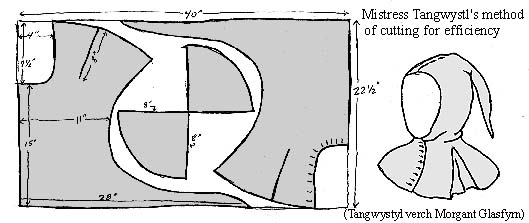Hood
A hood is a type of headgear that covers the neck and head, sometimes also covering the face. They are worn to protect from the elements, as a fashionable piece of garb, or as a form of head protection against bladed weapons. Hoods can be attached to a cloak or cape, or worn as a separate item.
In history
Hoods started out as basic, efficient clothing for everyone. They were worn both "normally" and as on top of the head as hats. Hoods eventually evolved into many different styles, depending on the social class of the wearer.
In Amtgard
Hoods, especially as a part of a cloak or cape, are essential pieces of cold-weather garb.
Making a hood
Hoods can be very customization. They can be trimmed with dags, bells, beads, and other embellishments. There are a variety of different hood patterns that can give very different finished looks.
Materials
The best fabric for hoods are woven natural fabrics, such as cotton, linen or wool. Scratchy fabrics can be lined with a softer one.
Pattern
Basic hoods are not much different than a folded piece of cloth with a seam in the back. They are usually fitted at the neck, to reduce bulk, make a better line, and keep them on the head better. More complex styles have longer liripipe, a wider face opening, or have sewn on ears to resemble a catperson.
You can dag the skirt in two ways: if you use fulled wool fabric, you can just snip ornamental dags out with scissors, or you can line the hood and sew dags.
The looser version of a hood takes about two yards of narrow material, doubled if you are using a lining. Reduce this estimate if you are making a fitted hood. If you are parti-ing your hood (one color on one side, another on the other) you need one yard of each color. Long liripipes can be pieced out of scraps.
Hood fittedness generally follows the style for other outerwear. If your garb is fitted, so should your hood fit snugly. If your garb is loose and flowy, so too, your should should be. Very fitted hoods will need buttons at the neck.
Liripipes should not be long enough to drag on the ground when the hood is hung around the neck, because you'll trip over them or get them exceedingly dirty. It is common to tuck the liripipe into your belt, or wrap it round your neck or the skirts of the hood, so that it doesn't drag as much.
Links
- Gallery of Hoods from medieval arts
- Article on different style of men's headdresses

